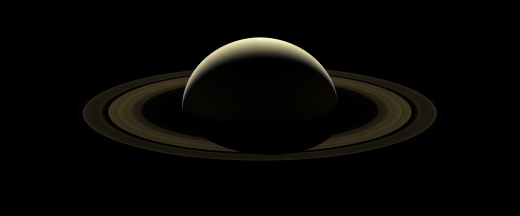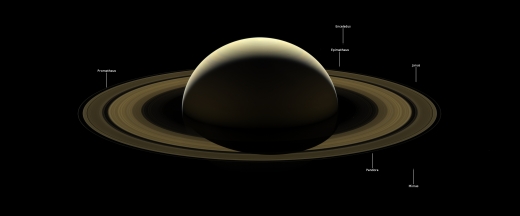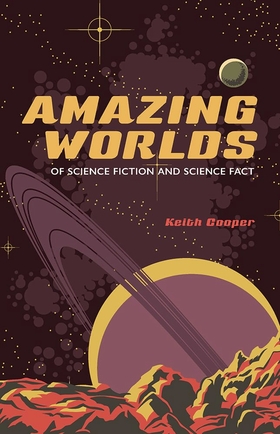Centauri Dreams
Imagining and Planning Interstellar Exploration
Problems with Red Dwarf Habitable Zones
Why all the fuss about red dwarf planets? We’re seeing so much ongoing work on these worlds because when it comes to terrestrial-class planets — in size, at least — those around red dwarfs are going to be our first targets for atmospheric characterization. A ‘habitable zone’ planet around a red dwarf throws a deep transit signature — small star, big planet — so that we can use transit spectroscopy to puzzle out atmospheric components. Getting an actual image would be even better, and modifications to the VISIR instrument at ESO’s Very Large Telescope, a project Breakthrough Initiatives is involved in along with the ESO, could eventually yield such.

We’ll know a great deal more about the possibilities as new missions come online, but for now, researchers are doing their best to apply models to what we know and deduce what surface conditions may be like around stars like TRAPPIST-1 and Proxima Centauri. Some of these results are not auspicious if it’s life we’re looking for. I’m looking at two papers from Chuanfei Dong (Princeton Plasma Physics Laboratory/Princeton University) that assess potential habitability, and in both cases there are significant reasons to question its likelihood.
Image: Princeton’s Chuanfei Dong. Credit: Princeton Plasma Physics Laboratory.
The assumption here is that an atmosphere must exist for long timescales to allow habitable conditions on the surface, and those long time-frames are precisely what is in question. Published earlier this year in the Astrophysical Journal Letters, the first of these papers develops models of the stellar wind, that outflow of charged particles that, in our own Solar System, defines the heliosphere around our Sun. This paper deals with the situation at Proxima Centauri b. The second paper, not yet published but available as a preprint, extends the study to the TRAPPIST-1 system, with results that are equally challenging for life.
While we have tended to focus habitability studies on factors like surface temperature (and this, in turn, is much dependent on atmosphere), Dong and colleagues are concerned about the effects of the stellar wind and atmosphere retention. Their simulations, performed using magneto-hydrodynamical (MHD) modeling that was originally developed for Venus and Mars, allow them to compute ion escape losses that would be expected at Proxima Centauri b.
Specifically, the Proxima paper examines the electromagnetic erosion of the atmosphere given the photo-chemical effects of the stellar wind, finding that the stellar inflow can ionize atoms in the planetary atmosphere, allowing these electromagnetic forces to sweep them into space. The result: Potentially severe atmospheric loss that would deplete the atmosphere of evaporated water, a cycle that could eventually leave the planetary surface dry.
A sufficiently high stellar wind pressure could cause extensive atmospheric loss, making any surface-based life that emerged a short-lived phenomenon. Says Dong:
“The evolution of life takes billions of years. Our results indicate that Proxima Centauri b and similar exoplanets are generally not capable of supporting an atmosphere over sufficiently long timescales when the stellar wind pressure is high. It is only if the pressure is sufficiently low, and if the exoplanet has a reasonably strong magnetic shield like that of the Earth’s magnetosphere, that the exoplanet can retain an atmosphere and has the potential for habitability.”
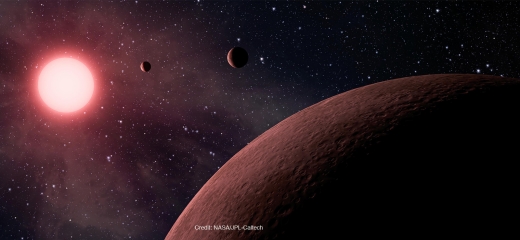
Image: Is the stellar wind capable of reducing a planetary atmosphere to the point where surface life is impossible? Credit: NASA/JPL-Caltech.
The paper finds that ion escape rates at Proxima b are two orders of magnitude higher than the terrestrial planets of our Solar System, assuming that the planet is unmagnetized. But even in the presence of a magnetosphere, ion escape rates are still higher than any we see in our system’s planets. The same issues apply at TRAPPIST-1, as noted in the new paper, which implicates stellar wind values as the primary driver in ion escape:
…as seen from our Solar system, the ion escape rates for Venus, Mars and Earth are similar despite their compositions, sizes and magnetic field strengths being wildly dissimilar (Lammer, 2013; Brain et al., 2016), thereby indicating that the ion escape rates may be more sensitive to stellar wind parameters; this is also partly borne out by the atmospheric ion escape rate calculations for Proxima b (Airapetian et al., 2017; Dong et al., 2017). Second, we observe that the inner planets of the TRAPPIST-1 system could have experienced significant losses of H2 and water over fast timescales (Bolmont et al., 2017; Bourrier et al., 2017), leaving behind other atmospheric components…
Dong also notes that planets close enough to be in a red dwarf’s habitable zone are likely tidally locked, producing constant bombardment on the star-facing side that would intensify the effects of atmospheric loss whether or not the planet has a protective magnetosphere. Earlier work has suggested that tidally locked planets are unlikely to have more than a weak magnetic field.
I’m focusing now on the TRAPPIST-1 paper because it’s the latest work on this matter, and it amplifies what was found in the earlier Proxima Centauri b work; I give citations for both papers below. Considering TRAPPIST-1 in light of stellar winds, the researchers argue that TRAPPIST-1h, viewed purely from the perspective of atmospheric loss, is the one most likely to have retained its atmosphere, but this is not a world where liquid water is possible on the surface. Dong and colleagues believe that TRAPPIST-1g thus represents “…the best chance for a habitable planet in this planetary system to support a stable atmosphere over long periods,” as the stellar wind effects diminish with distance.
It’s not a pleasant picture for those hoping for clement conditions on other planets around TRAPPIST-1 or Proxima Centauri. Oceans may once have existed there, but this work suggests that their surfaces today are probably dry. While the two papers focus on Proxima b and the TRAPPIST-1 worlds, Dong notes that the newly discovered planet around Ross 128 may have better prospects, as its star appears to be quieter than Proxima Centauri or TRAPPIST-1.
We should also note that an atmosphere can be replenished by outgassing, a reminder that analyzing an atmosphere over billion-year timeframes demands, as the paper notes, “…an in-depth understanding of the interplay between source and loss mechanisms.” Another issue: Stellar properties evolve, so that atmospheric escape rates change. This may not work to life’s advantage, however, for pre-main sequence M-dwarfs, according to Dong’s simulations, would produce even stronger stellar wind effects upon a young planet’s atmosphere.
The implications for other planetary systems seem clear:
For a given star, the mass-loss rate is fixed, implying that the escape rate is lower for smaller planets orbiting at greater distances. Hence, we suggest the following strategy for prioritizing studies of multi-planetary systems. If more than one exoplanet resides within the HZ of a given star, it may be more prudent to focus on the outward planet(s) since the atmospheric escape rates are likely to be lower. Similarly, when confronted with two planets with similar values of Rx and a [radius and semi-major axis], we propose that searches should focus on stars with lower mass-loss rates and magnetic activity.
The examination of the effects of stellar winds will proceed with soon-to-be-launched missions like the James Webb Space Telescope, allowing us to put theoretical work to the test. Given the surprises we’ve consistently found even with our interplanetary probes, Pluto being the most recent example, we can fairly confidently expect to modify our views with each new exoplanet atmospheric characterization. For now, though, these continuing studies raise serious questions about red dwarf planets as a clement venue for life.
The papers are Dong et al., “Is Proxima Centauri b habitable? — A study of atmospheric loss,” Astrophysical Journal Letters Vol. 837, No. 2 (10 March 2017) (abstract/ preprint); and Dong et al., “Atmospheric escape from the TRAPPIST-1 planets and implications for habitability,” accepted at Astrophysical Journal Letters (preprint).

Ozone Problematic for Biosignature Detection
TRAPPIST-1 and its seven interesting planets may be the most compelling stellar system we’re investigating, given the range of worlds here and the possibilities for analyzing an entire, nearby planetary system. But as we look toward examining systems like this with new space- and ground-based instruments, we may run into problems with searching for biosignatures. Both the TRAPPIST-1 planets and the promising Proxima Centauri b may be tough to characterize.
The problem: When searching for biosignatures, we’re looking for signs of metabolism, gases that are continually produced and remain out of balance in a planetary atmosphere. Ozone is one piece of the puzzle, one that signifies oxygen. Finding the latter in the same atmosphere with methane would be a compelling biosignature. But ozone could be hard to detect.
Ludmila Carone (Max Planck Institute for Astronomy) and colleagues now find that atmospheric circulation in planets close enough to red dwarfs to be in their habitable zone may mask the very signs we’re looking for. Ozone may become undetectable, trapped in equatorial regions.
The issue involves atmospheric flows, which will likely differ from what we see on Earth. The ozone in our stratosphere is formed when ultraviolet light from the Sun triggers chemical reactions in the oxygen molecules that make up approximately one-fifth of our atmosphere. The ozone protects us from harmful ultraviolet radiation from the Sun, and is distributed throughout the atmosphere owing to large-scale air flows moving from the equatorial regions to the poles.
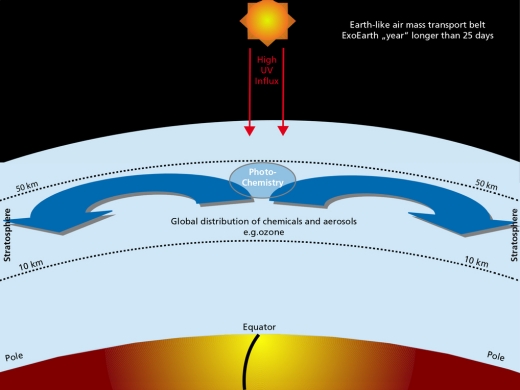
Image: Earth’s atmosphere has a “transportation belt” of air flows which move ozone from the main production areas near the equator towards the poles. This mechanism is important for creating Earth’s global ozone layer. Credit: MPIA (L. Carone & Graphics Dept.)
The problem for exoplanetology is that red dwarf planets in orbits of less than 25 days may be tidally locked to their star, presenting the same face to it at all times. Tidal lock, which we’ve examined often in these pages, could conceivably still allow enough heat to circulate to avoid the kind of extremes between dark and light sides that could prevent life from emerging. But for planets like these, Carone’s models show major air flows moving in the opposite direction, from the poles to the equator. The ozone we seek, then, could be trapped in the equatorial region.
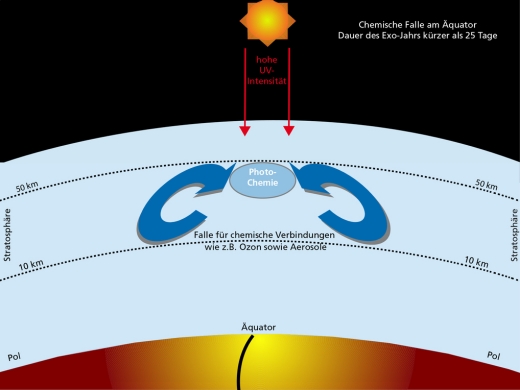
Image: As a new study by Ludmila Carone shows, certain exoplanets could have air flows that serve to trap ozone in the equatorial regions. This could present an unforeseen complication for the search for traces of life on these planets. For those who don’t speak German — my apologies, but I only have this image with German annotation. Credit: MPIA (L. Carone & Graphics Dept.)
This possibility is one we’ll need to consider as we begin the analysis of atmospheres on terrestrial-class planets around nearby red dwarfs. We may find no ozone on planets where ozone and oxygen might actually exist, though sequestered in places that might be difficult to detect. That’s a reverse take on the usual ‘false positive’ problem we’ve discussed here before, with abundant oxygen, for example, not necessarily being a marker for biological activity.
On the other hand, it’s worth asking whether a planet with ozone only in its equatorial regions would be capable of developing life in the first place. On that score, Carrone has an answer:
“In principle: yes. Proxima b and TRAPPIST-1d orbit red dwarfs, reddish stars that emit very little harmful UV-light to begin with. On the other hand, these stars can be very temperamental, and prone to violent outbursts of harmful radiation including UV. There is still a lot that we don’t know about these red dwarf stars. But I’m confident we will know much more in five years.”
True enough, assuming a successful launch of instruments like the James Webb Space Telescope, and the gradual emergence of the next generation of ground-based instruments. But as a marker for oxygen and potential life, exoplanet ozone may be a challenging detection.
The paper is Carone et al., “Stratosphere circulation on tidally locked ExoEarths,” Monthly Notes of the Royal Astronomical Society Vol. 473, Issue 4, pp. 4672-4685 (abstract).

Thinking About Saturn After Cassini
Several recent news items on Enceladus have me wanting to catch up with mission possibilities and the instruments that will drive them. NASA’s thinking in that direction takes in a remote sensing instrument called SELFI, an acronym standing for Submillimeter Enceladus Life Fundamentals Instrument. The plan here is to examine the chemical composition of the plumes of water vapor and icy particles that are regularly lofted into space from Enceladus’ south pole, in the region we’ve come to know as the ‘tiger stripes.’
Cassini data on the slight wobble in the orbital motion of Enceladus backs up the idea that the ocean beneath its ice is global, a body likely kept liquid by tidal energies as the moon is pulled and squeezed by Saturn in its orbit. The same process is likely the cause of the cracks that allow ocean water to escape into space, from perhaps as many as 100 sites on the surface.
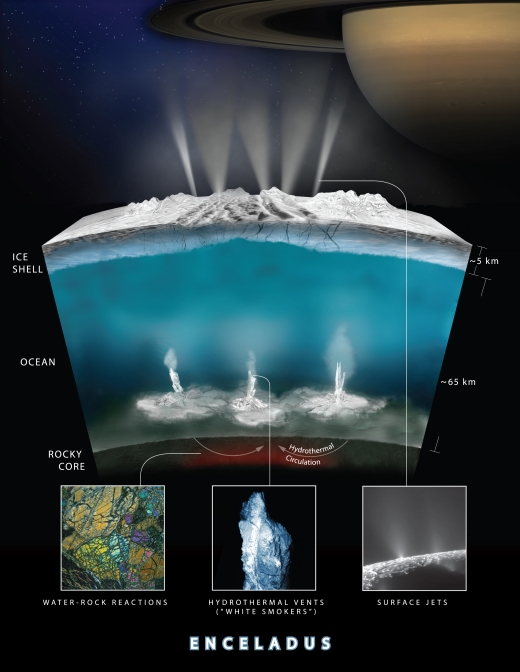
Image: The Cassini spacecraft detected hydrogen in the plume of gas and icy material spraying from Enceladus during its deepest and last dive through the plume on Oct. 28, 2015. This graphic illustrates a theory on how water interacts with rock at the bottom of the moon’s ocean, producing hydrogen gas. A Goddard team wants to develop an instrument that would reveal even more details about the hydrothermal vents and perhaps help answer if life exists on this ocean world. Credit: NASA/JPL-Caltech/Southwest Research Institute.
Gordon Chin (NASA GSFC), principal investigator for SELFI, describes it as a significant improvement over current submillimeter-wavelength technologies. Says Chin:
“Submillimeter wavelengths, which are in the range of very high-frequency radio, give us a way to measure the quantity of many different kinds of molecules in a cold gas. We can scan through all the plumes to see what’s coming out from Enceladus. Water vapor and other molecules can reveal some of the ocean’s chemistry and guide a spacecraft onto the best path to fly through the plumes to make other measurements directly.”
The GSFC team is using NASA R&D funding to increase the spectrometer’s sensitivity in the 557 GHz range, where the strongest signal from water is to be found. The goal is to explore the entire system of surface vents on Enceladus, measuring water and traces of other gases. The work also includes creating a radio frequency data-processing system, and a digital spectrometer for the RF signal that will convert it into digital signals to allow the measurement of the gases emerging from the plumes in terms of their quantity, temperature and velocity.
Calling it “one of the most ambitious submillimeter instruments ever built,” Chin says in this NASA overview that SELFI should be able to detect and analyze 13 molecular species, ranging from water in various isotopic forms to methanol, ammonia, ozone, hydrogen peroxide, sulfur dioxide, and sodium chloride. Work on the instrument is sufficiently encouraging that the GSFC team believes SELFI will eventually be part of a proposal for a future mission to Saturn.
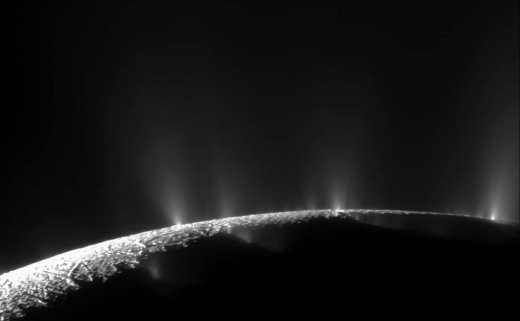
Image: Dramatic jets of ice, water vapor and organic compounds spray from the south pole of Saturn’s moon Enceladus in this image captured by NASA’s Cassini spacecraft in November 2009. Credit: NASA/JPL-Caltech/Space Science Institute.
Assuming it flies, the instrument should allow us to deduce the composition of the global ocean, and its potential for hosting extraterrestrial life. We have no idea whether Enceladus has warm hydrothermal vents of the sort that sustain life at the bottom of Earth’s ocean, but the prospect is enticing not only for this moon but for many of the other icy moons in the outer Solar System.
Into Saturn’s Depths
On the subject of Saturn, be aware as well of an interesting mission possibility called Hera, proposed as an M-class mission led by the European Space Agency, with collaboration from NASA (thanks Mike Fidler for the tip). The plan here is to detach an atmospheric probe from a ‘carrier-relay’ spacecraft as it approaches Saturn, letting the Hera probe enter Saturn’s atmosphere to study its tropopause, descending to pressure levels of at least 10 bars.
From the proposal page:
The primary science objectives will be addressed by an atmospheric entry probe that would descend under parachute and carry out in situ measurements beginning in the stratosphere to help characterize the location and properties of the tropopause, and continue into the troposphere to pressures of at least 10 bars. All of the science objectives, except for the abundance of oxygen, which may be only addressed indirectly via observations of species whose abundances are tied to the abundance of water, can be achieved by reaching 10 bars.

The Hera proposal recalls two previous missions, the first being the Galileo probe that was carried aboard the main Galileo spacecraft to Jupiter, entering the Jovian atmosphere on December 7, 1995 and continuing to function for close to an hour as it descended. The other analog is, of course, Cassini carrying the Huygens probe for the spectacular 2005 landing on Titan. That was a collaboration between ESA and NASA that paid off handsomely, and it provides a model for the carrier/data relay spacecraft model that Hera would use.

New Work on Planetary Inflation
Once in space in 2018, the Transiting Exoplanet Survey Satellite (TESS) will be observing, among many other things, hundreds of thousands of red giant stars across the entire sky. Planets around red giants are an interesting topic, because such stars point to an evolutionary outcome our own Sun will share, and we’d like to know more about what happens to existing planets in such systems as the host star swells and reddens, engulfing inner worlds.
New work out of the University of Hawaii Institute for Astronomy now examines two ‘hot Jupiters’ around red giants, stellar systems where we see the gas giants swelling up as the result of processes that remain controversial. The inflated size of planets like these can be explained in at least two ways, one of which involves a slowing of the cooling in the planet’s atmosphere, which causes the planet to inflate soon after formation. But the data presented here, drawn from NASA’s K2 mission, tend to corroborate the thinking of co-author Eric Lopez (NASA GSFC) that direct energy input from the host star is the dominant cause of this planetary inflation.

Image: Upper left: Schematic of the K2-132 system on the main sequence.
Lower left: Schematic of the K2-132 system now. The host star has become redder and larger, irradiating the planet more and thus causing it to expand. Sizes not to scale. Main panel: Gas giant planet K2-132b expands as its host star evolves into a red giant. The energy from the host star is transferred from the planet’s surface to its deep interior, causing turbulence and deep mixing in the planetary atmosphere. The planet orbits its star every 9 days and is located about 2000 light years away from us in the constellation Virgo. Credit: Karen Teramura, UH IfA.
The work is now available in The Astronomical Journal, where lead author Samuel Grunblatt and team show that each of the two planets is about 30 percent larger than Jupiter, though in each case only about half as massive. The two planets — K2-132b and K2-97b — are similar in orbital periods, radii and masses. Each orbits its red giant star in about nine days, with planetary radii being calculated at 1.31 ± 0.11 RJ and 1.30 ± 0.07 RJ respectively.
The researchers used models to analyze the evolution of planets like these over time, determining that their radii are typical for planets receiving their current level of radiation, but calculating back to main sequence values of radiation, they find the gas giants would have been considerably smaller. Stellar flux flowing to the planets’ deep convective interiors could therefore explain their current size, an indication that planet ‘inflation’ is directly tied to stellar irradiation rather than delayed atmospheric cooling after the planets’ formation.
But other factors remain to be tested, metallicity in particular. From the paper:
Further studies of planets around evolved stars are essential to confirm the planet re-inflation hypothesis. Planets may be inflated by methods that are more strongly dependent on other factors such as atmospheric metallicity than incident flux. An inflated planet on a 20 day orbit around a giant star would have been definitively outside the inflated planet regime when its host star was on the main sequence, and thus finding such a planet could more definitively test the re-inflation hypothesis. Similarly, a similar planet at a similar orbital period around a more evolved star will be inflated to a higher degree (assuming a constant heating efficiency for all planets). Thus, discovering such a planet would provide more conclusive evidence regarding these phenomena.
Also in play is the issue of heating efficiency, which may well vary between planets depending on their composition. Back to TESS, whose investigations should complement these results. Grunblatt and team point out that TESS should be able to observe additional planets in roughly 10 day orbits around more evolved stars, including oscillating red giants. The data should allow us to distinguish between the delayed cooling possibility and stellar irradiation scenarios.
The paper is Grunblatt et al., “Seeing Double with K2: Testing Re-inflation with Two Remarkably Similar Planets around Red Giant Branch Stars,” Astronomical Journal Vol. 154, No. 6 (27 November 2017). Abstract / preprint.

Cassini’s Exquisite Last View
The release of Cassini’s last images of Saturn and its rings is a welcome event, a capstone to the mission that has taught us so much. What we see below is a series of images that have been grafted together, 42 red, green and blue images that allow us to see a wide-angle mosaic of Cassini’s view. The images were taken by the spacecraft’s wide-angle camera on September 13, and include the moons Prometheus, Pandora, Janus, Epimetheus, Mimas and Enceladus.
Image: After more than 13 years at Saturn, and with its fate sealed, NASA’s Cassini spacecraft bid farewell to the Saturnian system by firing the shutters of its wide-angle camera and capturing this last, full mosaic of Saturn and its rings two days before the spacecraft’s dramatic plunge into the planet’s atmosphere. During the observation, a total of 80 wide-angle images were acquired in just over two hours. This view is constructed from 42 of those wide-angle shots, taken using the red, green and blue spectral filters, combined and mosaicked together to create a natural-color view. Credit: NASA/JPL-Caltech/SSI.
I was glad to see some Cassini team members reminiscing about Voyager, whose journeys opened up the outer Solar System to close view, and continue to inform us about the interstellar medium. Thus Carolyn Porco, former Voyager imaging team member and Cassini’s imaging team leader at the Space Science Institute in Boulder, Colorado:
“For 37 years, Voyager 1’s last view of Saturn has been, for me, one of the most evocative images ever taken in the exploration of the solar system. In a similar vein, this ‘Farewell to Saturn’ will forevermore serve as a reminder of the dramatic conclusion to that wondrous time humankind spent in intimate study of our Sun’s most iconic planetary system.”
Here is a brightened view, processed to bring out detail in the fainter areas of the image. The six moons mentioned above show up faintly, but the annotations should help.
Image: The ice-covered moon Enceladus — home to a global subsurface ocean that erupts into space — can be seen at the 1 o’clock position. Directly below Enceladus, just outside the F ring (the thin, farthest ring from the planet seen in this image) lies the small moon Epimetheus. Following the F ring clock-wise from Epimetheus, the next moon seen is Janus. At about the 4:30 position and outward from the F ring is Mimas. Inward of Mimas and still at about the 4:30 position is the F-ring-disrupting moon, Pandora. Moving around to the 10 o’clock position, just inside of the F ring, is the moon Prometheus. Credit: NASA/JPL-Caltech/SSI.
We’re looking toward the sunlit side of the rings from about 15 degrees above the ring plane, with Cassini at approximately 1.1 million kilometers from the planet and on its final approach.
Titan’s Polar Vortex
Although Cassini is gone, we have vast amounts of data that will continue to generate new discoveries for quite some time, as witness the latest, a paper out of the University Of Bristol that discusses the atmospheric chemistry on Saturn’s largest moon, Titan. Lead author Nick Teanby has been studying Titan’s upper atmosphere, where in the polar regions we are seeing unexpected cooling, a process that differs from what we see on Earth, Venus and Mars.
Indeed, Titan’s polar vortex seems to be extremely cold. What we see on the other worlds is that the high altitude polar atmosphere on a planet’s winter hemisphere is warmed as a result of sinking air heating as it is compressed. It was Cassini’s Composite Infrared Spectrometer (CIRS) instrument that produced the observations Teanby has used to study this anomaly on Titan.
CIRS data showed the expected polar hot-spot beginning to develop in 2009, but temperatures dropped significantly by 2012 and remained as low as 120 K until late 2015, after which the expected hot-spot returned. Teanby explains what’s happening this way:
“For the Earth, Venus, and Mars, the main atmospheric cooling mechanism is infrared radiation emitted by the trace gas CO2 and because CO2 has a long atmospheric lifetime it is well mixed at all atmospheric levels and is hardly affected by atmospheric circulation. However, on Titan, exotic photochemical reactions in the atmosphere produce hydrocarbons such as ethane and acetylene, and nitriles including hydrogen cyanide and cyanoacetylene, which provide the bulk of the cooling.”
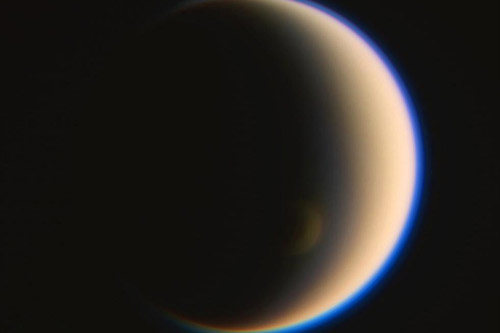
Image: Titan’s winter polar vortex imaged by the Cassini Spacecraft’s ISS camera. The vortex is now in deep winter and can only be seen because the polar clouds within the vortex extend high above Titan’s surface into the sunlight. The vortex was extremely cold from 2012-2015, giving rise to unusual nitrile ice clouds. Credit: NASA/JPL-Caltech/Space Science Institute/Jason Major.
Hydrocarbons and nitriles appear high in the atmosphere and are strongly susceptible to vertical atmospheric circulation, meaning that over the southern winter they accumulate in great amounts over the pole, creating the cooling Teanby and team are studying. The work also draws on Cassini data from 2014, when hydrogen cyanide ice clouds were observed over the pole, a reminder not only of Titan’s intriguing chemistry but the continuing vitality of Cassini data.
The paper is Teanby et al., “The formation and evolution of Titan’s winter polar vortex,” published online by Nature Communications 21 November 2017 (full text).

A Thought for the Weekend
From Arthur C. Clarke’s Interplanetary Flight: An Introduction to Astronautics (London: Temple Press Limited, 1960):
There is no way back into the past; the choice, as Wells once said, is the universe-or nothing. Though men and civilizations may yearn for rest, for the dream of the lotus-eaters, that is a desire that merges imperceptibly into death. The challenge of the great spaces between the worlds is a stupendous one; but if we fail to meet it, the story of our race will be drawing to its close.

